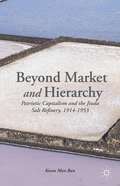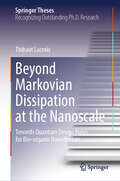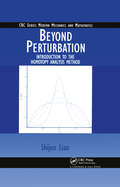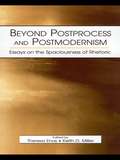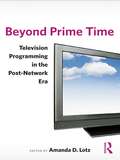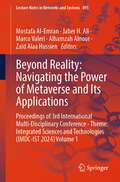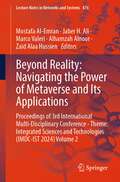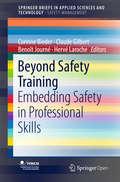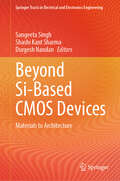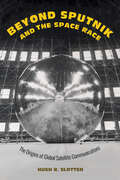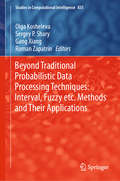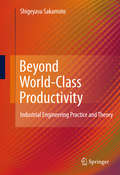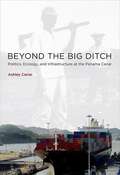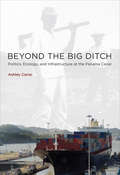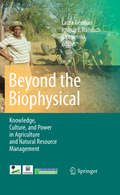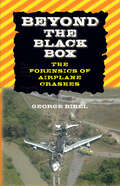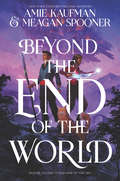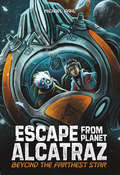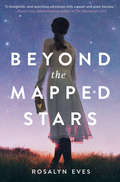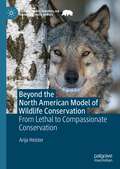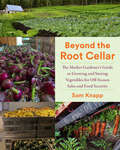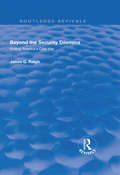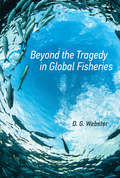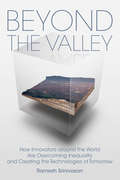- Table View
- List View
Beyond Market and Hierarchy
by Kwan Man BunBased on extensive archival research, Beyond Market and Hierarchy reconstructs how Fan waged modern China's war of salts. Led by his Jiuda Salt Industries, the nascent refined salt industry battled revenue farmers who, as a group, monopolized the production and distribution of evaporated salt.
Beyond Markovian Dissipation at the Nanoscale: Towards Quantum Design Rules for Bio-organic Nanodevices (Springer Theses)
by Thibaut LacroixThis book proposes innovative and timely modeling, as well as simulation strategies based on tensor networks, to tackle the difficult problem of describing the dynamics of open quantum systems at the molecular or nanometer scale beyond a Markovian treatment. Among the many insights it delivers, the work includes calculations of the dynamics of a quantum system coupled to a bosonic environment that can be potentially structured and/or possess spatial correlations. The relevance of these strategies is exemplified with the analysis of complex bio-inspired nanodevices. Researchers in the field will find here a clear and reliable contribution to the understanding of open quantum systems in a still little-explored regime where the reservoirs are no longer considered as simple baths but as sub-systems treated on an equal footing with the reduced system of interest. Moreover, the author discusses how to handle the situation of a system coupled to multiple baths. This is a very important and generic scenario, crucial, for instance, when discussing non-equilibrium steady states.
Beyond Perturbation: Introduction to the Homotopy Analysis Method (Modern Mechanics and Mathematics)
by Shijun LiaoSolving nonlinear problems is inherently difficult, and the stronger the nonlinearity, the more intractable solutions become. Analytic approximations often break down as nonlinearity becomes strong, and even perturbation approximations are valid only for problems with weak nonlinearity. This book introduces a powerful new analytic method for nonlinear problems-homotopy analysis-that remains valid even with strong nonlinearity. In Part I, the author starts with a very simple example, then presents the basic ideas, detailed procedures, and the advantages (and limitations) of homotopy analysis. Part II illustrates the application of homotopy analysis to many interesting nonlinear problems. These range from simple bifurcations of a nonlinear boundary-value problem to the Thomas-Fermi atom model, Volterra's population model, Von Karman swirling viscous flow, and nonlinear progressive waves in deep water. Although the homotopy analysis method has been verified in a number of prestigious journals, it has yet to be fully detailed in book form. Written by a pioneer in its development, Beyond Pertubation: Introduction to the Homotopy Analysis Method is your first opportunity to explore the details of this valuable new approach, add it to your analytic toolbox, and perhaps make contributions to some of the questions that remain open.
Beyond Postprocess and Postmodernism: Essays on the Spaciousness of Rhetoric
by Theresa Enos Keith D. MillerIn this collection of original essays, editors Theresa Enos and Keith D. Miller join their contributors--a veritable "who's who" in composition scholarship--in seeking to illuminate and complicate many of the tensions present in the field of rhetoric and composition. The contributions included here emphasize key issues in past and present work, setting the stage for future thought and study. The book also honors the late Jim Corder, a major figure in the development of the rhetoric and composition discipline. In the spirit of Corder's unfinished work, the contributors to this volume absorb, probe, stretch, redefine, and interrogate classical, modern, and postmodern rhetorics--and challenge their limitations. Beyond Postprocess and Postmodernism: Essays on the Spaciousness of Rhetoric will be of interest to scholars, teachers, and students in rhetoric and composition, English, and communication studies. Offering a provocative discussion of postprocess composition theories and pedagogies and postmodern rhetorics, as well as the first thorough consideration of Jim Corder's contributions, this work is certain to influence the course of future study and research.
Beyond Prime Time: Television Programming in the Post-Network Era
by Amanda LotzDaytime soap operas. Evening news. Late-night talk shows. Television has long been defined by its daily schedule, and the viewing habits that develop around it. Technologies like DVRs, iPods, and online video have freed audiences from rigid time constraints—we no longer have to wait for a program to be "on" to watch it—but scheduling still plays a major role in the production of television. Prime-time series programming between 8:00 and 11:00 p.m. has dominated most critical discussion about television since its beginnings, but Beyond Prime Time brings together leading television scholars to explore how shifts in television’s industrial practices and new media convergence have affected the other 80% of the viewing day. The contributors explore a broad range of non-prime-time forms including talk shows, soap operas, news, syndication, and children’s programs, non-series forms such as sports and made-for-television movies, as well as entities such as local affiliate stations and public television. Importantly, all of these forms rely on norms of production, financing, and viewer habits that distinguish them from the practices common among prime-time series and often from each other. Each of the chapters examines how the production practices and textual strategies of a particular programming form have shifted in response to sweeping industry changes, together telling the story of a medium in transition at the beginning of the twenty-first century. Contributors: Sarah Banet-Weiser, Victoria E. Johnson, Jeffrey P. Jones, Derek Kompare, Elana Levine, Amanda D. Lotz, Jonathan Nichols-Pethick, Laurie Ouellette, Erin Copple Smith
Beyond Reality: Proceedings of 3rd International Multi-Disciplinary Conference - Theme: Integrated Sciences and Technologies (IMDC-IST 2024) Volume 1 (Lecture Notes in Networks and Systems #895)
by Mostafa Al-Emran Marco Valeri Alhamzah Alnoor Jaber H. Ali Zaid Alaa HussienThis book addresses recent research trends concerning the role of the Metaverse in advancing the education and finance sectors from various perspectives. These trends are explored through multiple case studies employing diverse analytical approaches. The chapters aim to aid scholars and postgraduate students in pursuing future research in this domain and identifying potential developments in Metaverse applications.
Beyond Reality: Proceedings of 3rd International Multi-Disciplinary Conference - Theme: Integrated Sciences and Technologies (IMDC-IST 2024) Volume 2 (Lecture Notes in Networks and Systems #876)
by Mostafa Al-Emran Marco Valeri Alhamzah Alnoor Jaber H. Ali Zaid Alaa HussienThis book explores current research trends in the context of the Metaverse’s impact on the tourism and marketing industries while delving into some case studies on education and finance. These trends are examined through various case studies utilizing distinct analytical methods. The chapters are expected to support scholars and postgraduate students in furthering their research in this field and in recognizing prospective advancements in the applications of the Metaverse.
Beyond Safety Training: Embedding Safety in Professional Skills (SpringerBriefs in Applied Sciences and Technology)
by Corinne Bieder Claude Gilbert Benoît Journé Hervé LarocheThis book is open access under a CC BY 4. 0 license. This book investigates why, despite more and more resources devoted to safety training, expectations are not entirely met, particularly in the industrial sectors that have already achieved a high safety level. It not only reflects the most precious viewpoints of experts from different disciplines, different countries, with experiences in various industrial fields at the cutting edge of theories and practices in terms of safety, professionalization and their relationships. It also consolidates the positioning of the Foundation for an Industrial Safety Culture, highlighting what is currently considered at stake in terms of safety training, taking into account the system of constraints the different stakeholders are submitted to. It reports some success stories as well as elements which could explain the observed plateau in terms of outcome. It identifies some levers for evolution for at-risk industry and outlines a possible research agenda to go further with experimental solutions.
Beyond Si-Based CMOS Devices: Materials to Architecture (Springer Tracts in Electrical and Electronics Engineering)
by Sangeeta Singh Durgesh Nandan Shashi Kant SharmaThis book focuses on summarizing recent research trends for new beyond-CMOS and beyond-silicon devices, circuits, and architectures for computing. It reports the recent achievements in this field from leading research trends around the globe, specifically focusing on nanoscale beyond silicon materials and devices, functional nanomaterials, nanoscale devices, beyond-CMOS devices materials, and their opportunities and challenges. The book is devoted to the fast-evolving field of modern material science and nanoelectronics, particularly to the physics and technology of functional nanomaterials and devices.
Beyond Sputnik and the Space Race: The Origins of Global Satellite Communications
by Hugh R. SlottenA fascinating account of how the United States established the first global satellite communications system to project geopolitical leadership during the Cold War.On July 20, 1969, the world watched, spellbound, as NASA astronaut Neil Armstrong stepped off the Apollo 11 lunar module to walk on the moon. NASA estimated that 20 percent of the planet's population—nearly 650 million people—watched the moon landing footage, which was made possible by the first global satellite communications system, the International Telecommunications Satellite Organization, or Intelsat. In Beyond Sputnik and the Space Race, Hugh R. Slotten analyzes the efforts of US officials, especially during the Kennedy administration, to establish this satellite communication system and open it to all countries of the world. Locked in competition with the Soviet Union for both military superiority and international prestige, President John F. Kennedy overturned the Eisenhower administration's policy of treating satellite communications as simply an extension of traditionally regulated telecommunications. Instead of allowing private communications companies to set up separate systems that would likely primarily serve major "developed" regions, the new administration decided to take the lead in establishing a single world system. Explaining how the East-West Cold War conflict became increasingly influenced by North-South tensions during this period, Slotten highlights the growing importance of non-aligned countries in Asia, Latin America, and Africa. He also underscores the importance of a political economy of "total Cold War" in which many crucial aspects of US society became tied to imperatives of national security and geopolitical prestige. Drawing on detailed archival records to examine the full range of decisionmakers involved in the Intelsat system, Beyond Sputnik and the Space Race spotlights mid- and lower-level agency staff usually ignored by historians. One of the few works to analyze the establishment of a major global infrastructure project, this book provides an outstanding analytical overview of the history of global electronic communications from the mid-nineteenth century to the present.
Beyond Traditional Probabilistic Data Processing Techniques: Interval, Fuzzy etc. Methods and Their Applications (Studies in Computational Intelligence #835)
by Olga Kosheleva Sergey P. Shary Gang Xiang Roman ZapatrinData processing has become essential to modern civilization. The original data for this processing comes from measurements or from experts, and both sources are subject to uncertainty. Traditionally, probabilistic methods have been used to process uncertainty. However, in many practical situations, we do not know the corresponding probabilities: in measurements, we often only know the upper bound on the measurement errors; this is known as interval uncertainty. In turn, expert estimates often include imprecise (fuzzy) words from natural language such as "small"; this is known as fuzzy uncertainty. In this book, leading specialists on interval, fuzzy, probabilistic uncertainty and their combination describe state-of-the-art developments in their research areas. Accordingly, the book offers a valuable guide for researchers and practitioners interested in data processing under uncertainty, and an introduction to the latest trends and techniques in this area, suitable for graduate students.
Beyond World-Class Productivity: Industrial Engineering Practice and Theory
by Shigeyasu SakamotoFrom the automotive industry to the semiconductor industry, manufacturers are suffering from an overabundance of automation methods that they cannot fully comprehend or afford, and glamorous leadership techniques that are simply not sustainable. In this respect, management has lost its way. Beyond World-Class Productivity shows why a return to traditional tools and the power of people can help companies meet today's challenges in the manufacturing sector. Beyond World-Class Productivity gives readers a balance of essential information, theory and case studies. Readers can expect to gain new insights into engineering approaches to productivity, profitability and real or non-real gain, including: * useful tools for industrial engineering * effectiveness in unit labor costs; * feasibility studies * work simplification; and * developing mind innovation. Practical examples and their accompanying commentary come from the author's 40 years of real-world experience on the shop floor and in the boardroom. Figures are also provided to illustrate actual productivity results from real companies. Both managers and engineers can appreciate Beyond World-Class Productivity as an enlightening guide to the improvement of productivity and profitability within the manufacturing sector.
Beyond the Big Ditch
by Ashley CarseIn this innovative book, Ashley Carse traces the water that flows into and out from the Panama Canal to explain how global shipping is entangled with Panama's cultural and physical landscapes. By following container ships as they travel downstream along maritime routes and tracing rivers upstream across the populated watershed that feeds the canal, he explores the politics of environmental management around a waterway that links faraway ports and markets to nearby farms, forests, cities, and rural communities. Carse draws on a wide range of ethnographic and archival material to show the social and ecological implications of transportation across Panama. The Canal moves ships over an aquatic staircase of locks that demand an enormous amount of fresh water from the surrounding region. Each passing ship drains 52 million gallons out to sea -- a volume comparable to the daily water use of half a million Panamanians. Infrastructures like the Panama Canal, Carse argues, do not simply conquer nature; they rework ecologies in ways that serve specific political and economic priorities. Interweaving histories that range from the depopulation of the U.S. Canal Zone a century ago to road construction conflicts and water hyacinth invasions in canal waters, the book illuminates the human and nonhuman actors that have come together at the margins of the famous trade route. 2014 marks the 100th anniversary of the Panama Canal. Beyond the Big Ditch calls us to consider how infrastructures are materially embedded in place, producing environments with winners and losers.
Beyond the Big Ditch: Politics, Ecology, and Infrastructure at the Panama Canal (Infrastructures)
by Ashley CarseA historical and ethnographic study of the conflict between global transportation and rural development as the two intersect at the Panama Canal. In this innovative book, Ashley Carse traces the water that flows into and out from the Panama Canal to explain how global shipping is entangled with Panama's cultural and physical landscapes. By following container ships as they travel downstream along maritime routes and tracing rivers upstream across the populated watershed that feeds the canal, he explores the politics of environmental management around a waterway that links faraway ports and markets to nearby farms, forests, cities, and rural communities. Carse draws on a wide range of ethnographic and archival material to show the social and ecological implications of transportation across Panama. The Canal moves ships over an aquatic staircase of locks that demand an enormous amount of fresh water from the surrounding region. Each passing ship drains 52 million gallons out to sea—a volume comparable to the daily water use of half a million Panamanians. Infrastructures like the Panama Canal, Carse argues, do not simply conquer nature; they rework ecologies in ways that serve specific political and economic priorities. Interweaving histories that range from the depopulation of the U.S. Canal Zone a century ago to road construction conflicts and water hyacinth invasions in canal waters, the book illuminates the human and nonhuman actors that have come together at the margins of the famous trade route. 2014 marks the 100th anniversary of the Panama Canal. Beyond the Big Ditch calls us to consider how infrastructures are materially embedded in place, producing environments with winners and losers.
Beyond the Biophysical: Knowledge, Culture, and Power in Agriculture and Natural Resource Management
by Ritu Verma Laura German Joshua J. RamischBeyond the Biophysical provides a broad overview of agriculture and natural resource management (NRM) scholarship and practice that lies beyond the biophysical, emphasizing instead epistemological, cultural, and political foundations of NRM. The volume is oriented toward professionals with expertise in agriculture and natural resource management scholarship and practice, but who lack exposure to the conceptual and methodological underpinnings of critical theory, the anthropology of development, ecological anthropology, and other relevant scholarship. It therefore follows common standards of academic rigour, but minimizes the use of jargon, integrates detailed case studies with conceptual syntheses, and attempts to move from critique to concrete recommendations for scholarship and practice. The volume seeks to foster a more nuanced and responsible engagement with local communities and the natural world among NRM scholars and practitioners.
Beyond the Black Box: The Forensics of Airplane Crashes
by George BibelThe black box is orange—and there are actually two of them. They house the cockpit voice recorder and the flight data recorder, instruments vital to airplane crash analyses.But accident investigators cannot rely on the black boxes alone. Beginning with the 1931 Fokker F-10A crash that killed legendary football coach Knute Rockne, this fascinating book provides a behind-the-scenes look at plane wreck investigations. Professor George Bibel shows how forensic experts, scientists, and engineers analyze factors like impact, debris, loading, fire patterns, metallurgy, fracture, crash testing, and human tolerances to determine why planes fall from the sky—and how the information gleaned from accident reconstruction is incorporated into aircraft design and operation to keep commercial aviation as safe as possible.
Beyond the Blast Furnace
by Amit ChatterjeeThis unique book presents an in-depth analysis of all the emerging ironmaking processes, supplementing the conventional blast furnace method. Various processes for producing solid and liquid iron are discussed, including important features such as process outline, techno-economics, and process fundamentals. The present global status of each process is examined, projections for the future are made, and processes are compared.Beyond the Blast Furnace is valuable reading for process developers, because it gives them a complete picture of various process options. Conventional iron- and steelmakers as well as researchers and practitioners working in the area of alternative processes of ironmaking will also benefit from this ready reference. The book is an ideal text for undergraduate and postgraduate students in metallurgy.
Beyond the End of the World
by Amie Kaufman Meagan SpoonerPerfect for fans of Brandon Sanderson and Laini Taylor, this much-anticipated sequel to New York Times bestselling authors Amie Kaufman and Meagan Spooner’s The Other Side of the Sky is a thrilling race against time—with a tantalizing star-crossed love and an electric conclusion.Time to find a way between worlds. Time to find each other again. Time to do the impossible.Above, in the cloudlands, Nimh has no memory of her past, only an aching, undying certainty that she has left something—someone—behind. But while she struggles to recall her identity, an imposter wields her name with deadly purpose.Below, on the surface, North looks to the sky, desperate to join the person he loves and return to his world. But with only a traitor willing to help him, and others clamoring for him to take Nimh’s place, his home seems more unreachable than ever.Tragedy looms as the cloudland engines falter and mist rains terror on the surface, and in their desperation to reunite and save their people, Nimh and North face one ultimate question: can they defy their love and their destiny to save their homes?Or will the spark between them ignite their worlds, and consume them all together?Praise for The Other Side of the Sky: "Amie Kaufman and Meagan Spooner prove they are two living goddesses of writing, creating two compelling worlds with high stakes and gripping emotions." —Sarah Rees Brennan, New York Times bestselling author of the Demons Lexicon trilogy and the Lynburn Legacy series“A vivid and compulsive thriller set in a beautiful, perilous world of myths and treachery. You won’t want to put it down.” —Laini Taylor, New York Times bestselling author of the Daughter of Smoke and Bone series“I was left breathless by the book’s twists and turns, and was unprepared for the ending—it blew me away. Stop everything and read it!” —C. S. Pacat, bestselling author of Dark Rise“A book that absolutely shimmers with beauty.” —Buzzfeed
Beyond the Farthest Star (Escape from Planet Alcatraz)
by Michael DahlZak Nine and his Quom friend, Erro, are desperate to get off planet Alcatraz. The boys believe they've finally found a way to freedom when they join up with another prisoner. Together with their new partner, the boys board a small spacecraft and fly off the planet, past the metal moon, and head into space. But when the stars begin to look strange, Zak and Erro realize that something is very wrong. What will happen when the boys learn Planet Alcatraz's biggest secret? Will they ever get to return home?
Beyond the Mapped Stars
by Rosalyn EvesA sweeping adventure, set in the late 19th century, about science, love, and finding your place in the world, perfect for fans of Ruta Sepetys and Julie Berry.Seventeen-year-old Elizabeth Bertelsen dreams of becoming an astronomer, but she knows such dreams are as unreachable as the stars she so deeply adores. As a Mormon girl, her duty is to her family and, in a not too far away future, to the man who'll choose to marry her.When she unexpectedly finds herself in Colorado, she's tempted by the total eclipse of the sun that's about to happen--and maybe even meeting up with the female scientists she's long admired. Elizabeth must learn to navigate this new world of possibility: with her familial duties and faith tugging at her heartstrings, a new romance on the horizon, and the study of the night sky calling to her, she can't possibly have it all...can she?
Beyond the North American Model of Wildlife Conservation: From Lethal to Compassionate Conservation (The Palgrave Macmillan Animal Ethics Series)
by Anja HeisterThe North American Wildlife Conservation Model (NAM) is the driver of a strong anthropocentric stance, which has legalized an ongoing, annual exploitation of hundreds of millions of wild animals, who are killed in the United States through trapping, hunting and other lethal practices. Increasingly, the American public opposes the killing of wild animals for recreation, trophies and profit but has little—if any—knowledge of the Model. The purpose of this book is to empower the public with knowledge about the NAM’s insufficiencies and to help expedite the shift from lethal to compassionate conservation, an endeavour urgently needed particularly under the threats of climate change, human population growth and accelerating plant and animal species extinctions.With a focus on trapping, this book exposes the NAM's belief in human supremacy and its consequences for wild animals and their ecosystems, the same value that is driving the ongoing global destruction of nature and accelerating species extinction. Motivated by a deep concern for wild animals who suffer and whose lives are extinguished each year by 'sportsmen and women', this book exposes the violent treatment of wild animals inherent in governmental-promoted hunting and trapping programs, while emphasizing the importance of empathy and compassion for other animals in conservation and in our lives.
Beyond the Root Cellar: The Market Gardener's Guide to Growing and Storing Vegetables for Off-Season Sales and Food Security
by Sam Knapp&“Overflowing with invaluable tips and innovative strategies, this guide goes beyond the typical fast crops seen in most market gardens. . . I encourage all growers to study it and level up their farming game.&”—Jean-Martin Fortier, author of The Market Gardener and The Winter Market GardenerBeyond the Root Cellar is the inspiring guide that proves that—with a little ingenuity—the savvy grower can successfully select, harvest, store, and sell vegetables throughout the off-season, providing their family and community the local food they need during winter months.Sam Knapp built Offbeet Farm, a winter storage farm in interior Alaska, from the ground up. For the last four years, his success at Offbeet Farm has been a testament to the many benefits of growing crops for wintertime sales. His methods continually prove that winter storage is an excellent way to diversify a farm&’s offerings, spread the workload more evenly throughout the year, retain customers and employees during the off-season, and bolster local food systems.Beyond the Root Cellar is a compilation of insights, advice, and instruction, drawing on Sam&’s experience and that of many other storage farmers Sam has met along the way. It is, Sam says, the book he wishes he had when he embarked on his own winter storage business, and that he hopes will pave the way for growers both new and established who are interested in storage farming.In Beyond the Root Cellar, you&’ll find tips and tools for:Selecting crops and varieties that are best for storageNavigating the ins and outs of storage farm financials and planningHarvesting, processing, and moving crops into storageDesigning, creating, and managing temperature- and humidity-controlled storage areasAlso included are profiles of nine different storage farms, a crop compendium with in-depth information about eighteen storage crops, and full-color photography throughout that depicts a range of storage facilities, methods, and crops.Beyond the Root Cellar is the must-have, comprehensive winter storage handbook for a wide range of growers, from commercial farmers to market gardeners to homesteaders.&“This is next-level market gardening. Knapp is practical and inspiring . . . If you grow vegetables, I recommend that you pick up a copy of this book.&”—Ben Hartman, author of The Lean Micro Farm&“A must-read for anyone who wants to store produce for any length of time. . . , Even if you don&’t plan on storing produce all winter, this book will show you how to keep it as fresh as possible for as long as possible.&”—Andrew Mefferd, editor, Growing for Market magazine, author of The Greenhouse and Hoophouse Grower&’s Handbook
Beyond the Security Dilemma: Ending America's Cold War (Routledge Revivals)
by Jason G. RalphThis title was first published in 2001. The security dilemma has long been at the heart of the security studies discipline. Moving beyond this, this book attacks the assumptions of the traditional concept and redefines the security dilemma in a way more useful for examining security policy. By exposing the historical and social contingency of the traditional concept, the book argues that the security dilemma is an important though not a permanently operating feature of international politics. An examination of US policy towards the Soviet Union demonstrates the limits of perceiving the Cold War and challenges the role that American security policy has played in the process of constructing a transatlantic security community.
Beyond the Tragedy in Global Fisheries (Politics, Science, and the Environment)
by D. G. WebsterAn analysis of how responsive governance has shaped the evolution of global fisheries in cyclical patterns of depletion and rebuilding dubbed the “management treadmill.”The oceans are heavily overfished, and the greatest challenges to effective fisheries management are not technical but political and economic. In this book, D. G. Webster describes how the political economy of fisheries has evolved and highlights patterns that are linked to sustainable transitions in specific fisheries. Grounded in the concept of responsive governance, Webster's interdisciplinary analysis goes beyond the conventional view of the "tragedy of the commons.” Using her Action Cycle/Structural Context framework, she maps long-running patterns that cycle between depletion and rebuilding in a process that she terms the management treadmill.Webster documents the management treadmill in settings that range from small coastal fishing communities to international fisheries that span entire oceans. She identifies the profit disconnect, in which economic incentives are out of sync with sustainable use, and the power disconnect, in which those who experience the costs of overexploitation are politically marginalized. She examines how these disconnects shaped the economics of expansion and documents how political systems failed to prevent related cycles of serial resource depletion. Webster also traces the increasing use of restrictive management in response to worsening fisheries crises and the emergence of new, noncommercial interests that demand greater management but also generate substantial conflict. She finds that the management treadmill is speeding up with population growth and economic development, and so concludes that sustainable fisheries can only exist within a sustainable global economic system.
Beyond the Valley: How Innovators around the World are Overcoming Inequality and Creating the Technologies of Tomorrow (The\mit Press Ser.)
by Ramesh SrinivasanHow to repair the disconnect between designers and users, producers and consumers, and tech elites and the rest of us: toward a more democratic internet.In this provocative book, Ramesh Srinivasan describes the internet as both an enabler of frictionless efficiency and a dirty tangle of politics, economics, and other inefficient, inharmonious human activities. We may love the immediacy of Google search results, the convenience of buying from Amazon, and the elegance and power of our Apple devices, but it's a one-way, top-down process. We're not asked for our input, or our opinions—only for our data. The internet is brought to us by wealthy technologists in Silicon Valley and China. It's time, Srinivasan argues, that we think in terms beyond the Valley.Srinivasan focuses on the disconnection he sees between designers and users, producers and consumers, and tech elites and the rest of us. The recent Cambridge Analytica and Russian misinformation scandals exemplify the imbalance of a digital world that puts profits before inclusivity and democracy. In search of a more democratic internet, Srinivasan takes us to the mountains of Oaxaca, East and West Africa, China, Scandinavia, North America, and elsewhere, visiting the “design labs” of rural, low-income, and indigenous people around the world. He talks to a range of high-profile public figures—including Elizabeth Warren, David Axelrod, Eric Holder, Noam Chomsky, Lawrence Lessig, and the founders of Reddit, as well as community organizers, labor leaders, and human rights activists.. To make a better internet, Srinivasan says, we need a new ethic of diversity, openness, and inclusivity, empowering those now excluded from decisions about how technologies are designed, who profits from them, and who are surveilled and exploited by them.
